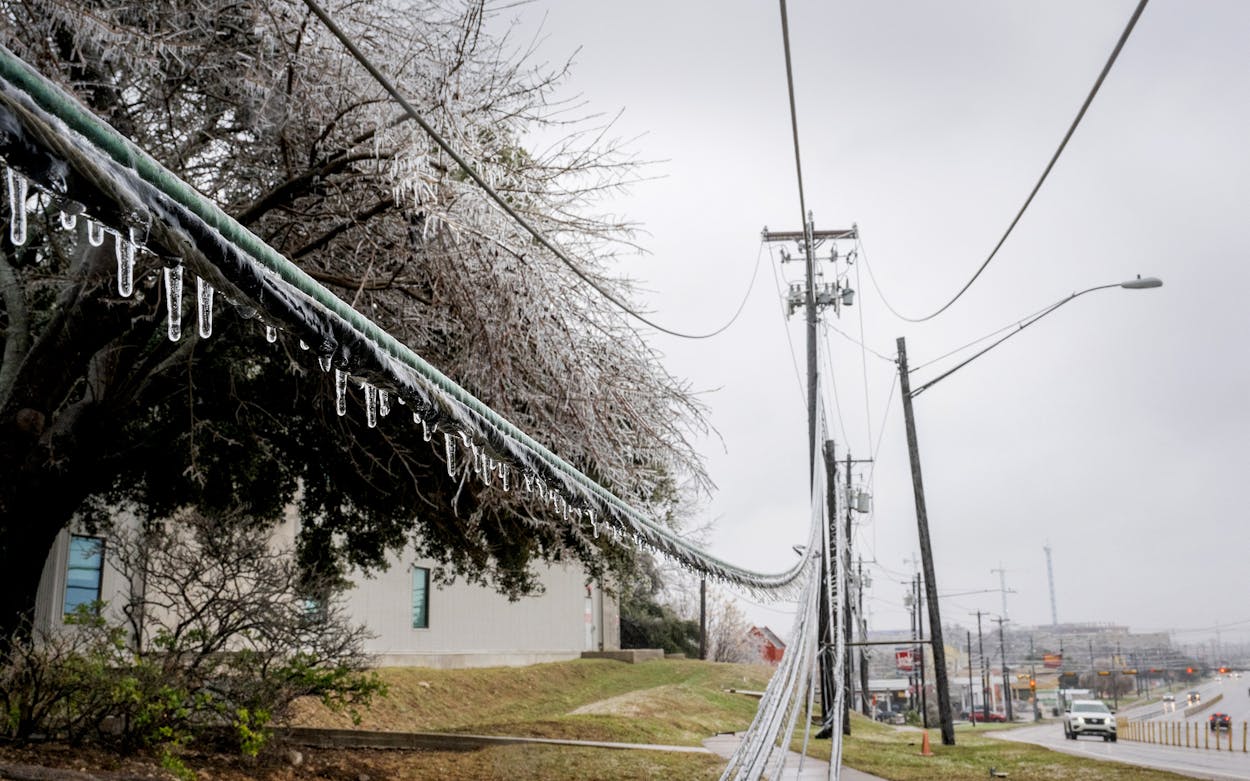Usually it sounds like distant thunder punctuated by a bone-splitting crack. Then the lights flicker before going out. Sometimes, it’s silent. Hundreds of pounds of ice weigh down a branch, which sags onto a power line, stretching it until the copper and steel tendrils snap. And then the lights go out.
This week, for the second time in less than two years, hundreds of thousands of Texans were left sitting in extended winter darkness. Only this time, the culprit wasn’t an Arctic blast that froze up power plants and gas infrastructure—it was icy trees.
The “oakpocalypse” has wreaked havoc across much of the Hill Country through Central Texas and into northeast Texas, places where the Quercus virginiana, the live oak, has taken root. These beautiful specimens have branches that grow thick and spread far from the trunk. Add the accumulation of days of freezing rain, and limbs are soon severed, snapping the sources of the electrical lifeblood of our modern world like dictionaries dropping through single-ply paper towels.
The result? As of Friday morning, Austin’s municipal utility, Austin Energy, was still reporting 122,535 homes and businesses in the dark—many of them having gone 48 hours without heat in the chilly weather. Oncor Electric, which serves much of North Texas and the Midland-Odessa area, had 73,010 customers cut off, according to the website Poweroutage.us, and Pedernales Electric Cooperative, based in the Hill Country, still had 23,489 energy-deprived customers. It raises the question of why we don’t just bury our power lines underground to avoid such a mess.
It’s difficult to bury lines, especially in heavily developed areas, where veritable mazes of internet cables, sewer pipes, and natural gas lines have already been implanted in the ground. Floodplains make for another onerous challenge too, since electricity and water don’t mix well. For these and other reasons, then, the simple answer is it would cost too much.
There’s not a lot of good data on exactly how expensive burying power lines would be, but in 2021, Northern California’s PG&E proposed burying 10,000 miles of its overhead power lines, which have been causing destructive and deadly wildfires. The utility said the cost is running close to $2.5 million per mile.
Austin Energy has 12,035 miles of local distribution lines. Say half of those miles need to be buried—using the PG&E example to project, you’re still talking $15 billion. The city would have to take on a massive amount of debt to fund such a project. Likewise, assume Oncor Electric only needs to bury a quarter of its 90,178 miles of overhead lines because—well, there aren’t a lot of trees in Midland. The company would still be looking at paying $56 billion or so, more than ten times what it cost to run its system in 2021.
Connie Piloto, a spokeswoman for Oncor, told me “cost plays a role, along with a number of other factors. In some cases, it is not physically possible to install underground equipment.” A subdivision developer could put its utilities underground as a selling point, but it would have to pay for that extra cost and presumably pass it along to home buyers.
Austin Energy’s then vice president of engineering, Thomas Pierpoint, said that “it’s prohibitively expensive to bury all the lines” at a city council meeting last year. Electrical rates are already rising across the state, as soaring electric and gas costs resulting from the 2021 blackout and electrical-market meltdown are passed on consumers. Marking up bills even more, to pay off the necessary debt to bury lines, would be a tough pill for many customers to swallow.
The Legislature could earmark some of its record-breaking surplus to help pay for utilities to put wires underground, but even that $33 billion pile of cash isn’t enough to go all the way around.
The only places where electrical lines are routinely buried are the downtown areas of big cities. There the streets are too crowded for a bunch of creosote-soaked poles, so utilities put their lines underfoot. We need to keep our sidewalks clear for scooters and grocery-delivering robots, after all.
There’s one more thing to remember, said Oncor’s Piloto. When there is a problem with a line, it’s a lot easier to find and fix it when lines are aboveground. Going subterranean to find shorts takes a lot of time. Of course, there might be a lot fewer problems to fix all at once.








